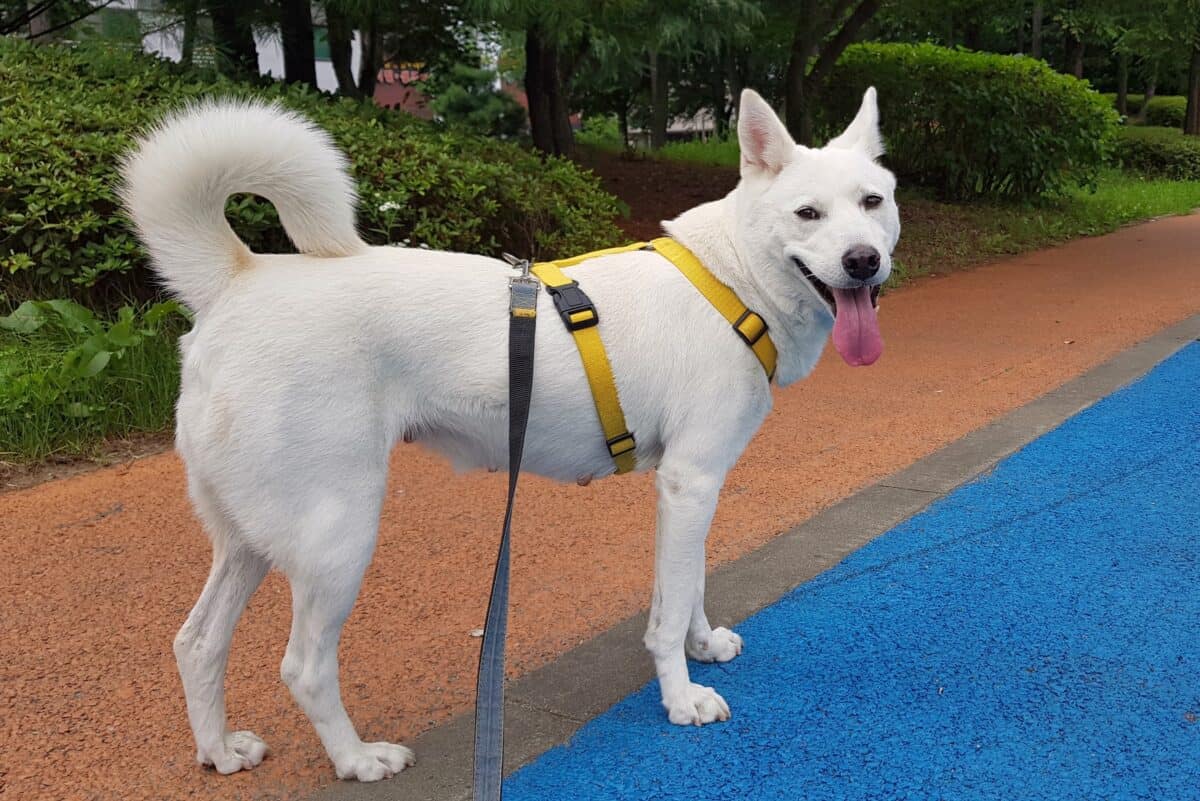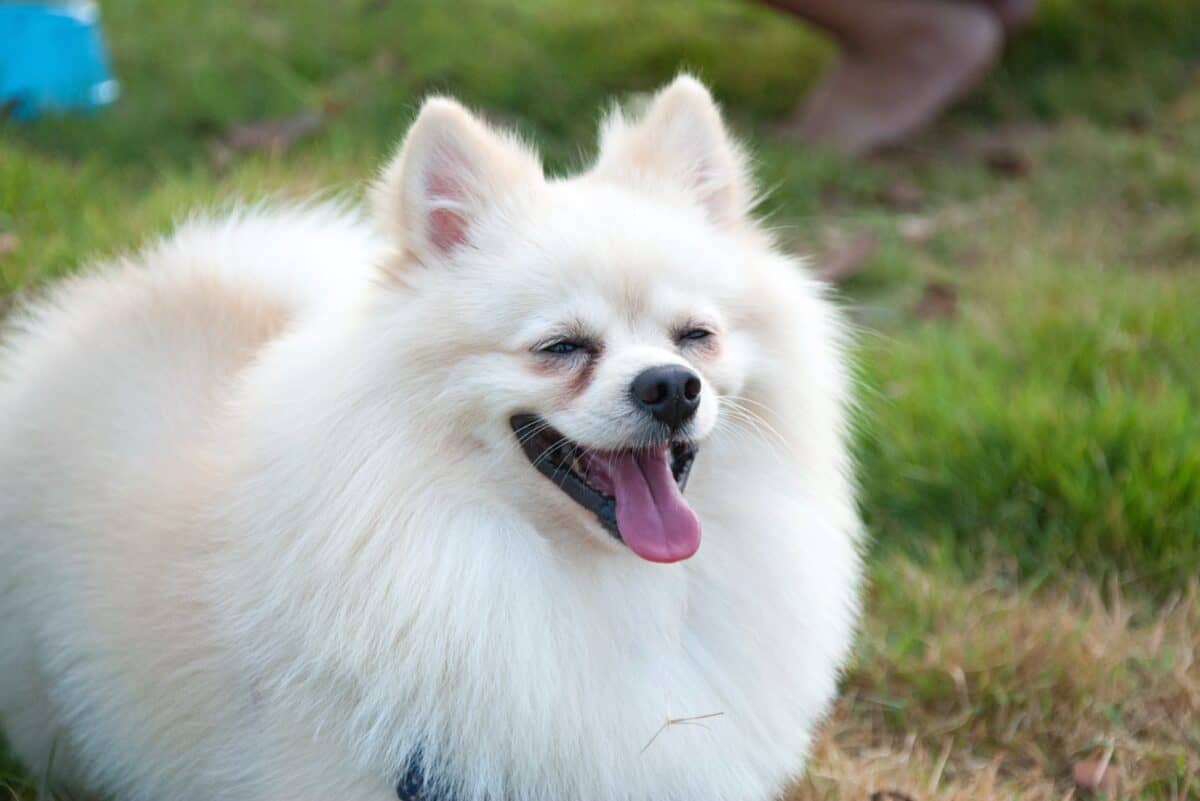
Finding a dog with a purple tongue is challenging. Most dog owners worry when they encounter dog breeds with purple tongues because it’s an uncommon feature.
A substance called melanin causes the natural purple tongues of several dog breeds. It might take the form of patches, solid color on the tongue, or a birthmark-like appearance.
Only a few breeds have purple tongues. When the tongue is not naturally purple, it could be a sign of illness or other problems.
So, what dog breeds have naturally purple tongues? To learn more, read along!
13 Dog Breeds With Purple Tongues
Given that it can take many distinct forms, purple tongues in dogs can be difficult to identify. Breeds can have solidly purple tongues, slightly bluish-toned tongues, tongues with purple patches, or purple birthmarks.
Check out the list below to get a better idea of what breeds may exhibit purple tongues:
1. Chow Chow

One distinguishing feature of Chows is their purple tongues. They are one of the few breeds that can have completely purple tongues. Further, the dots on their tongues may be purple or blue-black.
Chows are not born with purple tongues. They are born with pink tongues like other breeds. As they mature, the color begins to change and fully develops once they turn six months old.
Additionally, Chows tend to be quite territorial and can be hostile toward other dogs and pets because of their history as watchdogs for homes and livestock.
Further, Chows are best suited for owners with extensive expertise and the know-how to teach such a tenacious and independent breed.
Aside from this, owners should know how much to feed a Chow and its initial costs.
For a more detailed explanation of why Chows have purple tongues, check the video below:
2. Shar-Pei

Together with Chow Chows, Shar-Peis are among the few on this list that have naturally purple tongues. All Shar-Peis have purple tongues, which vary in shade from black to blue or lavender.
Compared to a Chow’s purple tongue, the tongue of a Shar-Pei is darker. Their purple tongue is believed to have been inherited from Tibetan wolves whom they descended from.
Aside from their purple tongue, Shar-Peis are regarded for their wrinkled skin, broad muzzle, sunken eyes, and triangular ears. Because of their numerous similarities, Shar-Peis are often bred together with Chows.
Shar-Peis may also come in different mixed breeds, such as the Walrus Dog, Sharp Eagle, Mini Hippo, and more. Moreover, they come in a variety of colors.
Shar-Peis are also known to be extremely devoted and loyal to their owners. Although they can be aloof with strangers, these purple-tongued dogs are highly intelligent and make great household companions.
3. Akita

Akitas, who look like skinny Chow Chows, naturally have pink tongues. However, it isn’t surprising to find one with purple or spotted tongues.
Unlike Chow Chows or Shar-Peis, Akitas with completely purple tongues can be difficult to find. Seeing one with blotched or spotted tongues, however, can be easier.
While they can be playful and affectionate with family members, this quiet and territorial breed is wary of strangers and often intolerant of other animals.
Despite being one of the costliest purebred dogs in the market today, Akitas are still popular among dog owners due to their personality, size, and relatively long lifespan.
Additionally, an Akita is an excellent watchdog, fit for families looking for a protective and loyal companion. Their strength and large size, however, are only suitable for experienced owners.
4. Eurasier

Eurasiers can have purple, pink, or spotted tongues. They are known for their wedge-shaped heads, triangular ears, and thick double coats.
Having a Chow Chow as one of their ancestors makes Eurasiers inherit its purple tongue. Purple tongues usually mean that a breed has a Chow Chow bloodline.
Like Chows, Eurasiers are known to be loyal to their family members but can be reserved towards strangers. They thrive in human companionship and must live in close contact with their family.
As even-tempered and affectionate dogs, Eurasiers are suitable for families who can be with them most of the time. They are also great with children of all ages, especially if they grew up with them.
5. Korean Jindo

Korean Jindos are rare as a breed itself, so finding one with a purple tongue can be extremely difficult!
Similar to Chows, Korean Jindos are historically regarded as hunting dogs. They came from the island of Jindo in South Korea. The exact reason why some of them have purple tongues is unknown.
Jindos are highly intelligent and easy to train. Generally, they have a calm temperament but can sometimes be aloof towards strangers. They are known for their unmatched loyalty to their owners.
These loyal companions make great household pets. Jindos are also suitable for owners looking for a devoted companion that will protect them at all costs.
6. Samoyed

A Samoyed naturally has a pink-colored tongue, and those who appear with purple, black, or bluish spots are believed to have at least a small percentage of Chows in their bloodlines.
The rarity of a purple-tongued Samoyed is roughly at the same level as that of a Black Samoyed. Aside from black and the Samoyed’s typical white color, it may also come in other colors.
This spitz-type breed descended from the Nenets Herding Laika of Russia. They are fearless breeds known to have endured hardships with their owners during Arctic expeditions.
Despite their tough history, Samoyeds today are regarded as smart and social dogs who thrive in love and attention from their owners. These purple-tongued dogs are intelligent, albeit with a touch of independence.
Samoyeds are also excellent family pets due to their friendly and affectionate nature. They are also great with kids and other pets as long as early socialization is done.
7. Border Collie

The tongues of Border Collies, an active breed, are frequently seen hanging out of their mouths. Because of this, owners can quickly spot any unusual pigmentation or color.
Border Collies naturally have pink tongues; however, some of them have completely purple tongues. Meanwhile, some Collies may also have tongues with bluish tones or tongues with blue-black patches.
Like their tongues, a Border Collie may come in different coat colors, such as blue, red merle, or tri-color.
Due to its obedience and agility, this type of highly trainable dog is frequently chosen as a herding companion. Individuals who enjoy energetic and active breeds will enjoy having these wonderful family dogs.
Collies are best suited for households with sizable backyards where they may run around and play. Collies that are not able to consume their pent-up energy may develop destructive behavior.
8. German Shepherd

The possibility of having a German Shepherd with a purple tongue is not entirely zero. Although rare, some can be seen with dark purple blotches on their tongues.
Pigment concentrations cause purple blotches in a German Shepherd’s tongue. These can be congenital or a sign of a health issue that warrants veterinary consultation.
German Shepherds are extremely loyal, courageous, and confident. Though they are gentle, it may take them time to make friends and get along with other pets.
Due to their history of herding, they are known to be loyal both to their work and to their owners. They are suitable for a variety of owners due to their well-balanced personalities.
Because of their wonderful personalities, German Shepherds are often mixed with lots of other breeds, such as the Rottweiler, Siberian Husky, Saint Bernard, Mastiff, Pitbull, Blue Heeler, Labrador, and even hound dogs.
9. Pomeranian

Pomeranians naturally have pink tongues, but some dogs may show purple-toned tongues or bluish spots. Unlike other breeds, a genetic defect may be the reason for a Pom’s purple tongue.
Poms with purple or bluish tongues may be suffering from congenital methemoglobinemia or a disorder that causes the blood to carry less oxygen than normal. This makes their tongue appear purple or bluish.
This genetic defect is caused by a mutation in their CYB5R3 gene, which can be found in most Pomeranians across the globe, particularly in Japan and Australia.
This disorder can be completely asymptomatic and require no specific therapy. Owners will still enjoy having a smart, energetic, affectionate, and playful companion.
Nonetheless, all Pomeranians are unique, and you may still get completely healthy pups as long as you ensure that you get yours from a reputable breeder and feed them a healthy and nutritious diet.
10. Rottweiler

Some Rottweilers may appear to have purple tongues due to dark spots or blotches of pigmentation. However, a Rottie with a completely purple tongue is a rare find.
It can be easy to see the color of a Rottweiler’s tongue as they usually have their tongues out. As large and active dogs, it helps them cool down and regulate their body temperature.
A Rottweiler’s large size can be intimidating, but they are wonderful and docile pets! They are incredibly loyal, devoted, and easygoing.
Rottweilers are suitable for owners looking for a gentle giant companion. Their intelligence makes them easy to train and introduce to children and other pets.
Rottweilers are undeniably popular and excellent companions, giving them a hefty price tag.
Nonetheless, owners should exercise due diligence and ensure that they’re getting their pups from reputable breeders.
11. Thai Ridgeback

Thai Ridgebacks are muscular dogs that may appear with solid or spotted purple tongues. Its tongue may also be gray, bluish-gray, or blue.
Thai Ridgebacks are native to Thailand and can be difficult to find outside Southeast Asia. However, some breeders are slowly beginning to find ways to bring this breed across the globe.
As a guarding breed, proper training and socialization are needed to ensure that they grow to be loyal and loving pets. Naturally, they are overprotective and can be aggressive toward strangers.
If you’re looking for a loyal family companion, a Thai Ridgeback is a good choice. However, it should be monitored carefully around toddlers and children.
12. Phu Quoc Ridgeback

The Phu Quoc Ridgeback, a native of the Phu Quoc island in Vietnam, is distinguished by its webbed feet and colored tongue.
There are believed to be less than a thousand Phu Quoc Ridgebacks in the entire world, making them an extremely rare breed. However, thanks to its hunting and sports prowess, it is gradually gaining popularity.
Like other Ridgeback breeds, Phu Quoc Ridgebacks are strong canines that the locals keep as guard and hunting dogs. They are naturally curious, which makes them quite intelligent and trainable.
Due to their strength, Phu Quoc Ridgebacks are best suited for owners with large outdoor spaces and homes in rural areas.
13. Tibetan Mastiff

Tibetan Mastiffs rarely appear with purple tongues, but they are prone to having dark blotches or spots that may look purple.
The spots and blotches on a Tibetan Mastiff’s tongue also tend to stand out as their tongues are almost the size of a small dog!
Although they appear intimidating due to their size, Tibetan Mastiffs are gentle and calm around the house. They are sweet and devoted to their family, although they tend to be territorial around strangers.
A Tibetan Mastiff is an ideal guard dog and is suitable for families looking for a loyal companion. However, it needs an owner with the space and skills to manage large breeds.
Frequently Asked Questions

What Does a Dog’s Tongue Color Mean?
A dog’s tongue color can mean a lot of things. It can be an indication of their breed or an underlying health issue that needs immediate attention.
The normal color of a dog’s healthy tongue should be deep pink.
If your dog is not a colored-tongue breed, dark red, purple, or blue-tinged tongues can be a sign of heatstroke, exposure to toxins, anemia, heart or lung disease, or electric shock.
What Does It Mean If a Dog’s Tongue Is Purple?
Purple tongues in dogs can be indicative of their breed or underlying illnesses such as cyanosis. If a dog doesn’t naturally have a purple tongue, it can be an indication of insufficient oxygen supply in the blood.
This suggests that your dog might be having breathing problems and needs immediate medical care. If untreated, cyanosis can lead to hypoxemia, which results in irreversible damage or even death.
What Causes Purple Tongues in Dogs?
Dogs can develop a purple tongue for a variety of reasons, including heredity, illness, environment, and food. Purple tongues in healthy dogs are a result of a pigment called melanin in the mucous membrane.
Additionally, living in cold regions and cyanosis can both result in purple tongues in dogs. While the former is not an issue, the latter is a reason for a visit to a vet since it points to heart or respiratory illness.
Final Thoughts
Seeing a dog with a purple tongue can mean a lot of things. It can be natural, an indication of an underlying disease, or simply a result of their environment and diet.
In most cases, purple tongues in dogs are caused by pigmentation and may appear as purple spots instead of a solid color.
Other than Chows and Shar-Peis, it is challenging to find breeds with a completely purple tongue.
If you suspect that your dog’s tongue is purple due to health concerns, make sure that they are taken to a veterinary professional for the appropriate action.
Overall, dogs with purple tongues are pretty unique, and they are surely interesting to own.
But do you think purple tongues make dogs special? Share your thoughts about dogs with purple tongues in the comments!